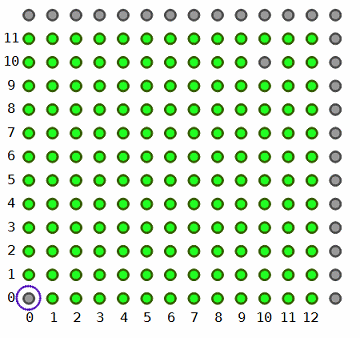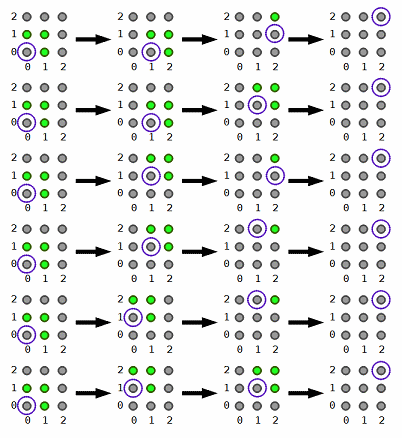Problem Statement |
| | Fox Ciel likes to jump around in large fields. She is currently at point (0, 0) of a field, and she wants to land at point (Tx, Ty) using exactly R jumps.
In one jump, she can move 0, 1, 2, ..., Mx units in the positive x direction and 0, 1, 2, ..., My units in the positive y direction. All jumps must have a non-zero distance. In addition, there are some jumps which she is not good at. These jumps are described in the int[] bad. If bad contains the number b, it means she cannot make a diagonal jump where she moves exactly b units in the positive x direction and b units in the positive y direction. Each element of bad will be a multiple of 10.
For instance, if Mx=12, My=11, bad={10} and she is at point (0, 0), then the only points she can jump to are the green ones shown below:

Return the number of ways she can start at (0, 0), jump exactly R times, and land at (Tx, Ty), modulo 10,007. Two ways are considered to be different if there is an index i, 0 <= i < R, such that Ciel lands at different points after the i-th (0-based) jump in these ways. |
| |
Definition |
| | | Class: | FoxJumping | | Method: | getCount | | Parameters: | int, int, int, int, int, int[] | | Returns: | int | | Method signature: | int getCount(int Tx, int Ty, int Mx, int My, int R, int[] bad) | | (be sure your method is public) |
|
| |
|
| |
Constraints |
| - | Tx and Ty will each be between 1 and 800, inclusive. |
| - | Mx and My will each be between 1 and 800, inclusive. |
| - | R will be between 1 and 1,600, inclusive. |
| - | bad will contain between 0 and 50 elements, inclusive. |
| - | Each element of bad will be between 1 and min(Mx, My), inclusive, and be a multiple of 10. |
| - | All elements of bad will be distinct. |
| |
Examples |
| 0) | |
| | | Returns: 1 | There is only 1 way to reach the destination.
 |
|
|
| 1) | |
| | | Returns: 6 | The following are the 6 ways she can reach her destination. Note that when she jumps, she must move a distance of at least one unit.
 |
|
|
| 2) | |
| | | Returns: 1 | She can jump only once, so there is 1 way to reach the destination. |
|
|
| 3) | |
| | | Returns: 0 | This case is almost the same as the previous one. However, in this case, the required jump is a bad jump, so she cannot reach the destination in a single jump. |
|
|
| 4) | |
| | |
| 5) | |
| | 123 | 456 | 70 | 80 | 90 | {30, 40, 20, 10, 50} |
| Returns: 6723 | |
|


